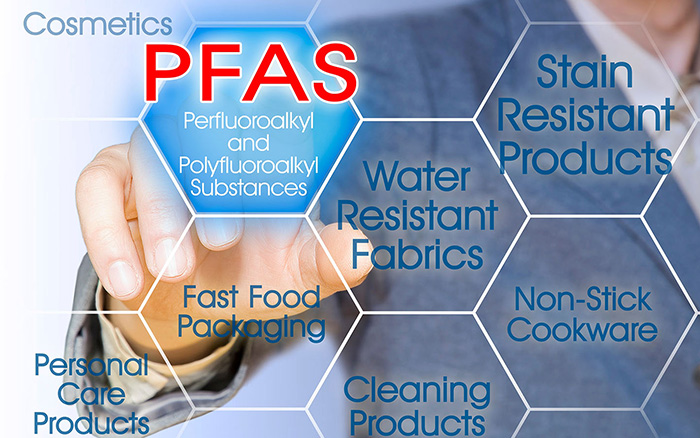ECHA committees conclude evaluation of several PFAS uses subject to proposed restrictions
Chemicals
| By SCOTT STEPHENS, MPA

ECHA’s committees for risk assessment (RAC) and socio-economic analysis (SEAC) met last week to continue work on developing opinions on the universal PFAS restriction proposal submitted in early 2023. New developments include the committees’ provisional evaluations on consumer uses of cosmetics and other mixtures, as well as industrial uses of metal plating and metal product manufacturing.
Regulatory context: PFAS and its universal restriction in the EU
- Per- and polyfluoroalkyl substances (PFAS), which are commonly used in textiles, impregnation agents, paints, firefighting foams (AFFF) and many other applications, have been linked to an increased risk of certain cancers, developmental effects and immunosuppression. These carbon-fluorine bonds are some of the strongest organic bonds, meaning that PFAS resist many common environmental stressors, including heat, water and oil. Consequently, many of these substances do not break down easily in the environment and exhibit a troubling capacity to accumulate in organisms. This extreme durability over time has resulted in the nickname “ forever chemicals.” Likewise, some have the propensity to travel great distances via air and sea currents, presenting a collective action problem that concerns the entirety of the EU.
- Five European nations – Denmark, Germany, the Netherlands, Norway, and Sweden –prepared a proposal in early 2023 that would universally restrict PFAS under Regulation (EC) 1907/2006 on the registration, evaluation, authorization and restriction of chemicals (REACH). After a six-month public consultation that ended last September with an unprecedented volume of stakeholder feedback (exceeding 5,600 comments), ECHA’s Committees for Risk Assessment and Socio-economic Analysis, RAC and SEAC, are now reviewing the restriction dossier. While both committees work on completing their respective opinions, the five countries that submitted the restriction continue to update the initial proposal based on stakeholder comments received.
ECHA reported on RAC’s and SEAC’s June plenary meetings, highlighting progress in evaluating the PFAS universal restriction proposal
- On June 13, ECHA announced that RAC and SEAC had reached provisional conclusions on restrictions for consumer uses of cosmetics, ski wax, and other mixtures, as well as industrial uses of metal plating and metal product manufacturing, with respect to the EU-wide proposal to restrict per- and polyfluoroalkyl substances (PFAS).
- RAC also tentatively reached conclusions on the proposal’s scope and the hazards of PFAS. The committee found the principal worry with PFAS is their persistence.
- Notably, RAC determined that excluding certain PFAS from the scope of the restriction based on their potential degradation in the environment cannot be adequately substantiated.
- The decisions reached at the committee meetings are tentative until RAC and SEAC have completed their evaluations of all use sectors contained in the restriction proposal, and adopted their respective opinions.
RAC and SEAC revealed the next sectors to be assessed at forthcoming meetings
- RAC and SEAC also disclosed their evaluation plans for the September and November meetings, announcing that in September they will assess possible restrictions on textiles, upholstery, leather, apparel, carpets (TULAC); food contact materials and packaging; and petroleum and mining. At their November meetings, the two committees will discuss fluorinated gas applications; as well as applications related to transport and construction products.
Other highlights from RAC’s and SEAC’s June plenary meetings
- In addition to PFAS restriction-related activities, RAC and SEAC agreed on opinions concerning 13 applications for authorization (AfAs) under REACH’s Title VII authorization scheme, among other issues addressed. They included opinions addressing uses of the Annex XIV-listed substances 4-NPnEO, 4-tert-OpnEO, potassium dichromate (CAS RN 7778-50-9); tetraethyllead (CAS RN 78-00-2); chromium trioxide (CAS RN 1333-82-0); DEHP (CAS RN 117-81-7); and sodium dichromate (CAS RN 10588-01-9).
Analysis and next steps
- ECHA, the Commission, and the dossier-submitting countries have, for the most part, refrained from providing a concrete timeline for completion of the PFAS restriction. For example, when ECHA received the restriction proposal in January 2023, it published a timeline that intentionally left blank the dates for delivery of its committees’ proposal evaluation and adoption of opinions, as well as the date when the opinions were expected to be forwarded to the Commission for a final decision on the proposed blanket restriction. At that time, only the Dutch competent authority (one of the five dossier submitters) speculated about the end of the process, stating that the ban was “expected to enter into force in 2025.”
- Like in past announcements, ECHA stated that it is “making every effort to progress opinion making, following the updates made to the proposal by the five national authorities,” with the promise only to deliver the opinions “to the European Commission as soon as possible.”
Key Documents and Dates
- Highlights from June RAC and SEAC meetings, June 13, 2024
- Minutes of the 69th Meeting of the Committee for Risk Assessment, June 10, 2024